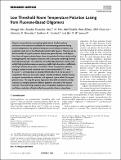Files in this item
Low-threshold room temperature polariton lasing from fluorene-based oligomers
Item metadata
| dc.contributor.author | Wei, Mengjie | |
| dc.contributor.author | Ruseckas, Arvydas | |
| dc.contributor.author | Mai, Van T. N. | |
| dc.contributor.author | Shukla, Atul | |
| dc.contributor.author | Allison, Ilene | |
| dc.contributor.author | Lo, Shih-Chun | |
| dc.contributor.author | Namdas, Ebinazar Benjamin | |
| dc.contributor.author | Turnbull, Graham | |
| dc.contributor.author | Samuel, Ifor D. W. | |
| dc.date.accessioned | 2021-06-18T10:30:13Z | |
| dc.date.available | 2021-06-18T10:30:13Z | |
| dc.date.issued | 2021-08-13 | |
| dc.identifier | 273967717 | |
| dc.identifier | 91cf2989-bc6a-44db-8ffb-100d01372af6 | |
| dc.identifier | 000662733200001 | |
| dc.identifier | 85108364676 | |
| dc.identifier.citation | Wei , M , Ruseckas , A , Mai , V T N , Shukla , A , Allison , I , Lo , S-C , Namdas , E B , Turnbull , G & Samuel , I D W 2021 , ' Low-threshold room temperature polariton lasing from fluorene-based oligomers ' , Laser & Photonics Reviews , vol. 15 , no. 8 , 2100028 . https://doi.org/10.1002/lpor.202100028 | en |
| dc.identifier.issn | 1863-8880 | |
| dc.identifier.other | ORCID: /0000-0001-9114-3522/work/95772479 | |
| dc.identifier.uri | https://hdl.handle.net/10023/23387 | |
| dc.description | The authors are grateful to the Australian Research Council (ARC DP160100700 and DP200103036), Australian Department of Industry, Innovation and Science (AISRF53765), the UK Engineering and Physical Sciences Research Council (Grants EP/M025330/1 and EP/L017008/1), China Scholarship Council and the Rank Prize Funds for financial support. | en |
| dc.description.abstract | Organic semiconductors possessing tightly bound Frenkel excitons are known to be attractive candidates for demonstrating polariton lasing at room temperature. As polariton lasing can occur without inversion, it is a potential route to very low threshold coherent light sources. However, so far, the thresholds of organic polariton lasers have generally been much higher than those of organic photon lasers. Here this problem has been addressed by investigating two new organic molecules with a structure combining fluorene and carbazole groups. The materials are readily deposited from solution and exhibit high photoluminescence quantum yields, high absorption coefficients, and large radiative decay rates in neat films. Room temperature polariton lasing is realized in both materials with incident thresholds of 13.5 and 9.7 µJ cm−2, corresponding to absorbed thresholds of 3.3 and 2.2 µJ cm−2, respectively. These are the lowest values reported to date for polariton lasing in organic semiconductor materials, and approach typical values for organic photon lasers. The step-like power dependent blue-shift of polariton modes indicates an interplay between different depletion channels of the exciton reservoir. This work brings practical room temperature polaritonic devices and future realization of electrically driven polariton lasers a step closer. | |
| dc.format.extent | 8 | |
| dc.format.extent | 2492791 | |
| dc.language.iso | eng | |
| dc.relation.ispartof | Laser & Photonics Reviews | en |
| dc.subject | Excitons | en |
| dc.subject | Microcavities | en |
| dc.subject | Organic semiconductors | en |
| dc.subject | Strong light-matter coupling | en |
| dc.subject | QC Physics | en |
| dc.subject | TK Electrical engineering. Electronics Nuclear engineering | en |
| dc.subject | DAS | en |
| dc.subject.lcc | QC | en |
| dc.subject.lcc | TK | en |
| dc.title | Low-threshold room temperature polariton lasing from fluorene-based oligomers | en |
| dc.type | Journal article | en |
| dc.contributor.sponsor | EPSRC | en |
| dc.contributor.sponsor | EPSRC | en |
| dc.contributor.institution | University of St Andrews. School of Physics and Astronomy | en |
| dc.contributor.institution | University of St Andrews. Sir James Mackenzie Institute for Early Diagnosis | en |
| dc.contributor.institution | University of St Andrews. Centre for Biophotonics | en |
| dc.contributor.institution | University of St Andrews. Condensed Matter Physics | en |
| dc.identifier.doi | 10.1002/lpor.202100028 | |
| dc.description.status | Peer reviewed | en |
| dc.identifier.grantnumber | EP/M025330/1 | en |
| dc.identifier.grantnumber | ep/l017008/1 | en |
This item appears in the following Collection(s)
Items in the St Andrews Research Repository are protected by copyright, with all rights reserved, unless otherwise indicated.

